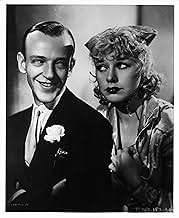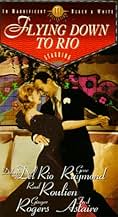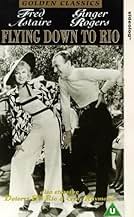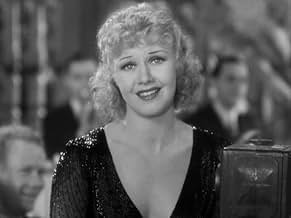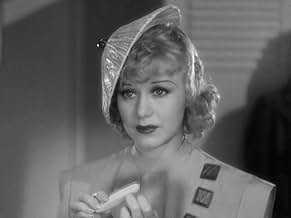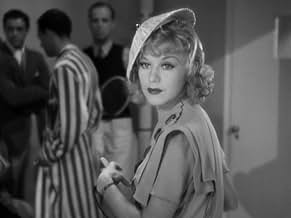IMDb रेटिंग
6.6/10
4.2 हज़ार
आपकी रेटिंग
अपनी भाषा में प्लॉट जोड़ेंA bandleader woos a Latin flame who is already engaged to his employer.A bandleader woos a Latin flame who is already engaged to his employer.A bandleader woos a Latin flame who is already engaged to his employer.
- 1 ऑस्कर के लिए नामांकित
- 1 जीत और कुल 2 नामांकन
Dolores Del Río
- Belinha De Rezende
- (as Dolores Del Rio)
Luis Alberni
- Rio Casino Manager
- (बिना क्रेडिट के)
Bernice Alstock
- Singer
- (बिना क्रेडिट के)
Chita Andrews
- Check Girl
- (बिना क्रेडिट के)
फ़ीचर्ड समीक्षाएं
The first pairing of Astaire and Rogers, playing second leads to Dolores DelRio and a slightly strabismic Gene Raymond. What music and what dancing!!! And the scenery of 1933 Rio is worth seeing. The story is slight, the acting is slighter but who cares when Astaire and Rogers take the floor for the Carioca. How silly is the concept of a bunch of girls strapped to the wings of airplanes performing over the hotel? But again, who cares?...it's history on film as the seminal appearance of the most famous dance team in the movies. The supporting players are good but what became of Raul Roulien?.....the rest are familiar to fans of old movies. Love the music,(even Orchids in the Moonlight)and especially the title tune which is rather forgotten now. Step back in time and enjoy this dated, but absolutely wonderful film. You won't be sorry and maybe you will dance the Carioca!!
I gave this "Fred Astaire" comedy-romance-musical higher marks than normal because the romance, usually the sappy part of the Astaire films, doesn't dominate as it does most of his movies.
As usual, there are a number of interesting dance scenes including a spectacular Busby Berkeley-type production on the wings of airplanes. That scene has to be seen to be believed, not just for the uniqueness of it but for the bra-less women pictured! Yikes, it's not something you expect to see with a classic film - and you wouldn't see for another 35 years. It's pretty amazing.
I really shouldn't label this an "Astaire film " because Dolores Del Rio and Gene Raymond are the two stars. Astaire is a close third. Raul Roulien would be next while Ginger Rogers just has a small role.....but it IS noteworthy for being the first time all of us saw the famous Astaire-Rogers pairing.
The comedy in this film also is pretty good. The best parts of the film are the beginning and end. The fadeout segways in here reminded of silent films, which weren't that long removed from this.
As usual, there are a number of interesting dance scenes including a spectacular Busby Berkeley-type production on the wings of airplanes. That scene has to be seen to be believed, not just for the uniqueness of it but for the bra-less women pictured! Yikes, it's not something you expect to see with a classic film - and you wouldn't see for another 35 years. It's pretty amazing.
I really shouldn't label this an "Astaire film " because Dolores Del Rio and Gene Raymond are the two stars. Astaire is a close third. Raul Roulien would be next while Ginger Rogers just has a small role.....but it IS noteworthy for being the first time all of us saw the famous Astaire-Rogers pairing.
The comedy in this film also is pretty good. The best parts of the film are the beginning and end. The fadeout segways in here reminded of silent films, which weren't that long removed from this.
Howard Hughes, oh how we needed you.
From other sources you will have learned that this is pretty sexy stuff in terms of transparent clothes; not a bra on the hundreds of candidates. And the original dirty dancing before it was outlawed, and that crack about what Brazilian women have "below the equator." Also, you will have heard about this being the first Astaire-Rogers pairing.
You may not have heard of one of the most racially respectful scenes I know from the era: a couple land on a supposedly deserted island and the woman is frightened by what she thinks are natives. Turns out one comes out of the woods. He's playing golf and while shirtless (in order to make the joke work) speaks English normally and carries himself like a regular man. Its the reverse joke of what you'd usually see in bugeyed stepinfetchits.
But what I find fascinating is the way sex, romance, money and music are all somehow related to aviation. Our hero, we are told is heir to a fortune if only he would give up his music and planes. But it is plain that he does it because of the women. And by that we know he means sex, only sex. We first see him as he climbs out of his plane, which has a piano stuffed in it. Now think about that a minute.
This is what technology meant in those days: adventure, charm, bodily pleasure. And its what the sort of music we see in films was supposed to imply as well. If you do not see this, let me describe the climax. Scores of scantily clad women are strapped to what looks like a dozen small planes to perform choreographically as best you can when bolted down. Every shot you can take of a woman's body is presented, along with a wingload of errant nipples. I can just imagine the smiles when they thought it up.
There's something else to watch for. This has the most elaborate transitions I believe I have seen for any film. They really are amazingly varied and so copious they are as much a feature as Fred's dancing.
Ted's Evaluation -- 2 of 3: Has some interesting elements.
From other sources you will have learned that this is pretty sexy stuff in terms of transparent clothes; not a bra on the hundreds of candidates. And the original dirty dancing before it was outlawed, and that crack about what Brazilian women have "below the equator." Also, you will have heard about this being the first Astaire-Rogers pairing.
You may not have heard of one of the most racially respectful scenes I know from the era: a couple land on a supposedly deserted island and the woman is frightened by what she thinks are natives. Turns out one comes out of the woods. He's playing golf and while shirtless (in order to make the joke work) speaks English normally and carries himself like a regular man. Its the reverse joke of what you'd usually see in bugeyed stepinfetchits.
But what I find fascinating is the way sex, romance, money and music are all somehow related to aviation. Our hero, we are told is heir to a fortune if only he would give up his music and planes. But it is plain that he does it because of the women. And by that we know he means sex, only sex. We first see him as he climbs out of his plane, which has a piano stuffed in it. Now think about that a minute.
This is what technology meant in those days: adventure, charm, bodily pleasure. And its what the sort of music we see in films was supposed to imply as well. If you do not see this, let me describe the climax. Scores of scantily clad women are strapped to what looks like a dozen small planes to perform choreographically as best you can when bolted down. Every shot you can take of a woman's body is presented, along with a wingload of errant nipples. I can just imagine the smiles when they thought it up.
There's something else to watch for. This has the most elaborate transitions I believe I have seen for any film. They really are amazingly varied and so copious they are as much a feature as Fred's dancing.
Ted's Evaluation -- 2 of 3: Has some interesting elements.
FLYING DOWN TO RIO (RKO Radio, 1933), directed by Thornton Freeland, is a musical showcase for Mexican star Dolores Del Rio playing a Brazilian beauty named Belinia De Rezende, Gene Raymond as Roger Bond, a girl chasing orchestra leader, and Raul Roulien as Julio Rubeiro as Belinia's fiancé and Roger's best friend who complicates matters. By the film's conclusion, the ones who "walked off" with the movie are the supporting players of Ginger Rogers as the band vocalist, and Fred Astaire as the accordionist-dancer, in that order, thus, the beginning of a new screen team, and never again in the persona of sassy Honey Hale and semi-sophisticated Fred Ayres. Yet it's amazing that Astaire and Rogers made such a lasting impression at all in this production, considering they play subordinate roles who supply "comedy relief," and have very little opportunity to act or dance together. Even in the famous, "Carioca," number (which was how they became crowned "The King and Queen of the Carioca"), they get to perform only a few dance steps, but the ensemble of other dancers and singers get most of the footage during its 12 minutes. But even without Astaire and Rogers, or either with one of them along with a different partner, FLYING DOWN TO RIO remains an early musical attempt to capture that South American feel and tango rhythm, predating all those cliché musicals MGM or 20th Century-Fox would distribute in the 1940s, with the addition of Technicolor and/or Xavier Cugat and Carmen Miranda, etc. As for the plot elements, it remains similar to the ones used in subsequent Astaire and Rogers films, but this time the situations of strangers meeting followed by a merry mix-up, belongs to its leading players (Del Rio, Raymond and Roulien). The first half of the movie takes place in Miami, Florida, where the plot development amongst the central characters begin, then shifts to Rio De Janiero, the second largest city in Brazil, where the complications continue and are resolved after 89 minutes of screen time. In between all this comes the singing and dancing to help the plot along.
With the music and lyrics by Gus Kahn, Edward Eliscu and Vincent Youmans, the songs include: "Music Makes Me" (sung by Ginger Rogers in the foreground with Fred Astaire, as one of the members of the band, playing the accordion in the background); "The Carioca" (performed by musicians, danced by numerous Brazilians, sung by Movita and Etta Moten, and danced briefly by Astaire and Rogers); "Orchids in the Moonlight" (sung by Raul Roulien to Dolores Del Rio/reprise, danced by Astaire and Del Rio, with one observer saying to another, "Oh, look, Belinha is dancing our tango with an Americano."); "Music Makes Me" (tap dance solo by Astaire); and "Flying Down to Rio" (sung by Fred Astaire/ danced by girls chained to the wings of the flying airplanes).
Other than some advanced camera techniques used in this production, portions of the movie play like a picture postcard advertisement, mainly during its montage sequences where the camera focuses first from an air-view of famous landmarks, then from the ground view of Rio De Janiero, and flipping over to other scenes of the city from people walking the streets to cars driving down the roads before returning to the storyline.
In the supporting cast are Blanche Frederici as Belinda's old-fashioned Aunt (Tia) Elena; Roy D'Arcy, Maurice Black and Armand Kaliz (The Greeks); Franklin Pangborn (Mr. Hammerstein); Luis Alberni (The Rio Casino Manager); and Eric Blore (Mr. Butterbass), making his first of five performances in an Astaire and Rogers musical. He is an asset to every one of them. It's also interesting to note that Raul Roulien remained somewhat obscure after appearing in this, never to become the Cesar Romero-type of Hollywood. As for the few Hollywood movies to feature him in the early 1930s, this is the only one still in circulation today and possibly his best opportunity on screen.
When Gene Raymond was interviewed about FLYING DOWN TO RIO in the documentary on RKO Radio titled "Hollywood, the Golden Years" (as narrated by Ed Asner back in the late 1980s), he mentioned that he thought that FLYING DOWN TO RIO was going to become the "Bomb of Bombs," but much to his surprise when it made its premiere during the Christmas season at Radio City Music Hall, he noticed while being in New York City that there was a long line of people going around the block waiting to go in and see this movie. One cannot be sure that history would repeat itself again in today's society, but FLYING DOWN TO RIO, in spite of whatever is right or wrong it it, is vintage entertainment at best. Only one debit: acrobats flipping and catching one other, and hanging on the swings under the wings of the flying airplane during the "Flying Down to Rio" number. Not realistic, but it got by. And on the historical side, this is where Astaire and Rogers got their start together on screen, thus, becoming the most popular song and dance team of the movies, never to be topped or equaled by anyone. Now that's something to think about!
FLYING DOWN TO RIO, which was formerly shown on American Movie Classics for many years, is currently presented on Turner Classic Movies. It is also available on video cassette and DVD. Recommended highly to fans of the team and/or musicals from this era. (***1/2)
With the music and lyrics by Gus Kahn, Edward Eliscu and Vincent Youmans, the songs include: "Music Makes Me" (sung by Ginger Rogers in the foreground with Fred Astaire, as one of the members of the band, playing the accordion in the background); "The Carioca" (performed by musicians, danced by numerous Brazilians, sung by Movita and Etta Moten, and danced briefly by Astaire and Rogers); "Orchids in the Moonlight" (sung by Raul Roulien to Dolores Del Rio/reprise, danced by Astaire and Del Rio, with one observer saying to another, "Oh, look, Belinha is dancing our tango with an Americano."); "Music Makes Me" (tap dance solo by Astaire); and "Flying Down to Rio" (sung by Fred Astaire/ danced by girls chained to the wings of the flying airplanes).
Other than some advanced camera techniques used in this production, portions of the movie play like a picture postcard advertisement, mainly during its montage sequences where the camera focuses first from an air-view of famous landmarks, then from the ground view of Rio De Janiero, and flipping over to other scenes of the city from people walking the streets to cars driving down the roads before returning to the storyline.
In the supporting cast are Blanche Frederici as Belinda's old-fashioned Aunt (Tia) Elena; Roy D'Arcy, Maurice Black and Armand Kaliz (The Greeks); Franklin Pangborn (Mr. Hammerstein); Luis Alberni (The Rio Casino Manager); and Eric Blore (Mr. Butterbass), making his first of five performances in an Astaire and Rogers musical. He is an asset to every one of them. It's also interesting to note that Raul Roulien remained somewhat obscure after appearing in this, never to become the Cesar Romero-type of Hollywood. As for the few Hollywood movies to feature him in the early 1930s, this is the only one still in circulation today and possibly his best opportunity on screen.
When Gene Raymond was interviewed about FLYING DOWN TO RIO in the documentary on RKO Radio titled "Hollywood, the Golden Years" (as narrated by Ed Asner back in the late 1980s), he mentioned that he thought that FLYING DOWN TO RIO was going to become the "Bomb of Bombs," but much to his surprise when it made its premiere during the Christmas season at Radio City Music Hall, he noticed while being in New York City that there was a long line of people going around the block waiting to go in and see this movie. One cannot be sure that history would repeat itself again in today's society, but FLYING DOWN TO RIO, in spite of whatever is right or wrong it it, is vintage entertainment at best. Only one debit: acrobats flipping and catching one other, and hanging on the swings under the wings of the flying airplane during the "Flying Down to Rio" number. Not realistic, but it got by. And on the historical side, this is where Astaire and Rogers got their start together on screen, thus, becoming the most popular song and dance team of the movies, never to be topped or equaled by anyone. Now that's something to think about!
FLYING DOWN TO RIO, which was formerly shown on American Movie Classics for many years, is currently presented on Turner Classic Movies. It is also available on video cassette and DVD. Recommended highly to fans of the team and/or musicals from this era. (***1/2)
By the time Flying Down to Rio was released in 1933, It was Warner Brothers who had been having the success as far as musicals were concerned.
Ruby Keeler and Dick Powell were the uncrowned King and Queen of song and dance land and in films like 42nd Street, Footlight Parade and Gold Diggers and the later movies Dames and Flirtation Walk they were paving the way for a motion picture genre that would continue in much the same vein for the next twenty years.
With kaleidescope routines expertly directed by Busby Berkeley via overhead cameras, the movie musical was finally taking shape bearing little or no resemblance to earlier dismal efforts like MGM'S Broadway Melody of 1929 or their equally unimpressive Hollywood Review from the same year.
RKO was at the time a struggling studio with huge debts and was on the verge of going bankrupt. However they decided to capitalize on this medium in an effort to pull themselves back into the black.
Flying Down to Rio was in all respects no different to any other of the films they produced at the time and I'm sure this film would have sank into obscurity and be long forgotten had it not been for the movie milestone it boasts.
Fred Astaire and Ginger Rogers were cast as only 3rd and 4th billed performers, to all intents and purposes, the token dance act, a novelty. Neither of them had done much before. Ginger of course was beginning to make a name for herself. She had featured in both the fore-mentioned 42nd Street and Gold Diggers and was slowly working her way out of chorus lines into bit parts and the occasional solo number.
Fred had done less still. Already a well known stage star in America and Britain, he had just one previous film under his belt. A natural dancer of extraordinary talent, Fred was signed on as RKO's secret weapon in their efforts to make the best musicals.
However, no matter how dull the storyline to "Rio" is (and it is believe me) it is soon forgotten when Fred and Ginger perform their first ever screen dance, The Carioca, a musical number with Latin- American tempo complete with stunning costumes, guest singers and the very kaleidoscopic shots of which Busby Berkeley himself would have been proud. It is their only dance together in the film and their actual dancing is given very limited screen-time, but it was enough to cause Astaire/Rogers mania.
Forgive the cliche but the rest is history as they say.
So successful were they that they went on to appear in a further nine films together making them one of the most beloved and cherished screen partnerships ever.
Alone the Astaire/Rogers musicals of the thirties saved the studio from closure and they helped push Warner's, Keeler and Powell into second place, at least as far as musicals were concerned.
Astaire is given further opportunity to shine in two stunning solos which will leave the viewer in no doubt whatsoever why he was the very best at his chosen craft.
Complete with the now famous 'girls-strapped-onto-aeroplane-wings' scene and with the added talents of Delores Del Rio and Gene Raymond adding the romance, It all helps to make an otherwise dull film into a legendary silver screen gem.
Ruby Keeler and Dick Powell were the uncrowned King and Queen of song and dance land and in films like 42nd Street, Footlight Parade and Gold Diggers and the later movies Dames and Flirtation Walk they were paving the way for a motion picture genre that would continue in much the same vein for the next twenty years.
With kaleidescope routines expertly directed by Busby Berkeley via overhead cameras, the movie musical was finally taking shape bearing little or no resemblance to earlier dismal efforts like MGM'S Broadway Melody of 1929 or their equally unimpressive Hollywood Review from the same year.
RKO was at the time a struggling studio with huge debts and was on the verge of going bankrupt. However they decided to capitalize on this medium in an effort to pull themselves back into the black.
Flying Down to Rio was in all respects no different to any other of the films they produced at the time and I'm sure this film would have sank into obscurity and be long forgotten had it not been for the movie milestone it boasts.
Fred Astaire and Ginger Rogers were cast as only 3rd and 4th billed performers, to all intents and purposes, the token dance act, a novelty. Neither of them had done much before. Ginger of course was beginning to make a name for herself. She had featured in both the fore-mentioned 42nd Street and Gold Diggers and was slowly working her way out of chorus lines into bit parts and the occasional solo number.
Fred had done less still. Already a well known stage star in America and Britain, he had just one previous film under his belt. A natural dancer of extraordinary talent, Fred was signed on as RKO's secret weapon in their efforts to make the best musicals.
However, no matter how dull the storyline to "Rio" is (and it is believe me) it is soon forgotten when Fred and Ginger perform their first ever screen dance, The Carioca, a musical number with Latin- American tempo complete with stunning costumes, guest singers and the very kaleidoscopic shots of which Busby Berkeley himself would have been proud. It is their only dance together in the film and their actual dancing is given very limited screen-time, but it was enough to cause Astaire/Rogers mania.
Forgive the cliche but the rest is history as they say.
So successful were they that they went on to appear in a further nine films together making them one of the most beloved and cherished screen partnerships ever.
Alone the Astaire/Rogers musicals of the thirties saved the studio from closure and they helped push Warner's, Keeler and Powell into second place, at least as far as musicals were concerned.
Astaire is given further opportunity to shine in two stunning solos which will leave the viewer in no doubt whatsoever why he was the very best at his chosen craft.
Complete with the now famous 'girls-strapped-onto-aeroplane-wings' scene and with the added talents of Delores Del Rio and Gene Raymond adding the romance, It all helps to make an otherwise dull film into a legendary silver screen gem.
क्या आपको पता है
- ट्रिवियाStanding outside a bakery shop in Rio, Ginger Rogers asks, "Oh, Freddie, how do you ask for little tarts in Portuguese?" Fred Astaire replies, "Don't heckle me, try the Culbertson System." This pre-Code, double entendre joke would have been funny to Depression-era audiences, for whom bridge was a common pastime. Ely Culbertson was a champion bridge player and worldwide celebrity, who had won several international tournaments by developing a rather aggressive bidding system. He was also notorious for his sexual exploits. His 1940 autobiography was banned in many countries. In the 1930s, the word "tart" was equivalent to "slut" or "whore". Also, in the opening inspection of hotel staff, the boss sees a maid whose shoe heels are oddly beveled and says he will not tolerate that sort of thing. A "round-heeled woman" was 1930s slang for a prostitute, a woman who could tilt easily from standing to being on her back.
- गूफ़From the height they were flying, most of the "dance" routines of the young women on the plane wings would not be visible to people on the ground.
While true, this observation is not a Goof. The purpose of the event likely was more for advertising or Newsreel value, or even simply "bragging rights".
- भाव
Belinha's Friend: What have these South Americans got below the equator that we haven't?
- कनेक्शनFeatured in Hollywood and the Stars: The Fabulous Musicals (1963)
- साउंडट्रैकMusic Makes Me
(1933) (uncredited)
Music by Vincent Youmans
Lyrics by Gus Kahn and Edward Eliscu
Performed by Ginger Rogers
टॉप पसंद
रेटिंग देने के लिए साइन-इन करें और वैयक्तिकृत सुझावों के लिए वॉचलिस्ट करें
- How long is Flying Down to Rio?Alexa द्वारा संचालित
विवरण
बॉक्स ऑफ़िस
- बजट
- $4,62,000(अनुमानित)
- चलने की अवधि
- 1 घं 29 मि(89 min)
- रंग
- पक्ष अनुपात
- 1.37 : 1
इस पेज में योगदान दें
किसी बदलाव का सुझाव दें या अनुपलब्ध कॉन्टेंट जोड़ें


